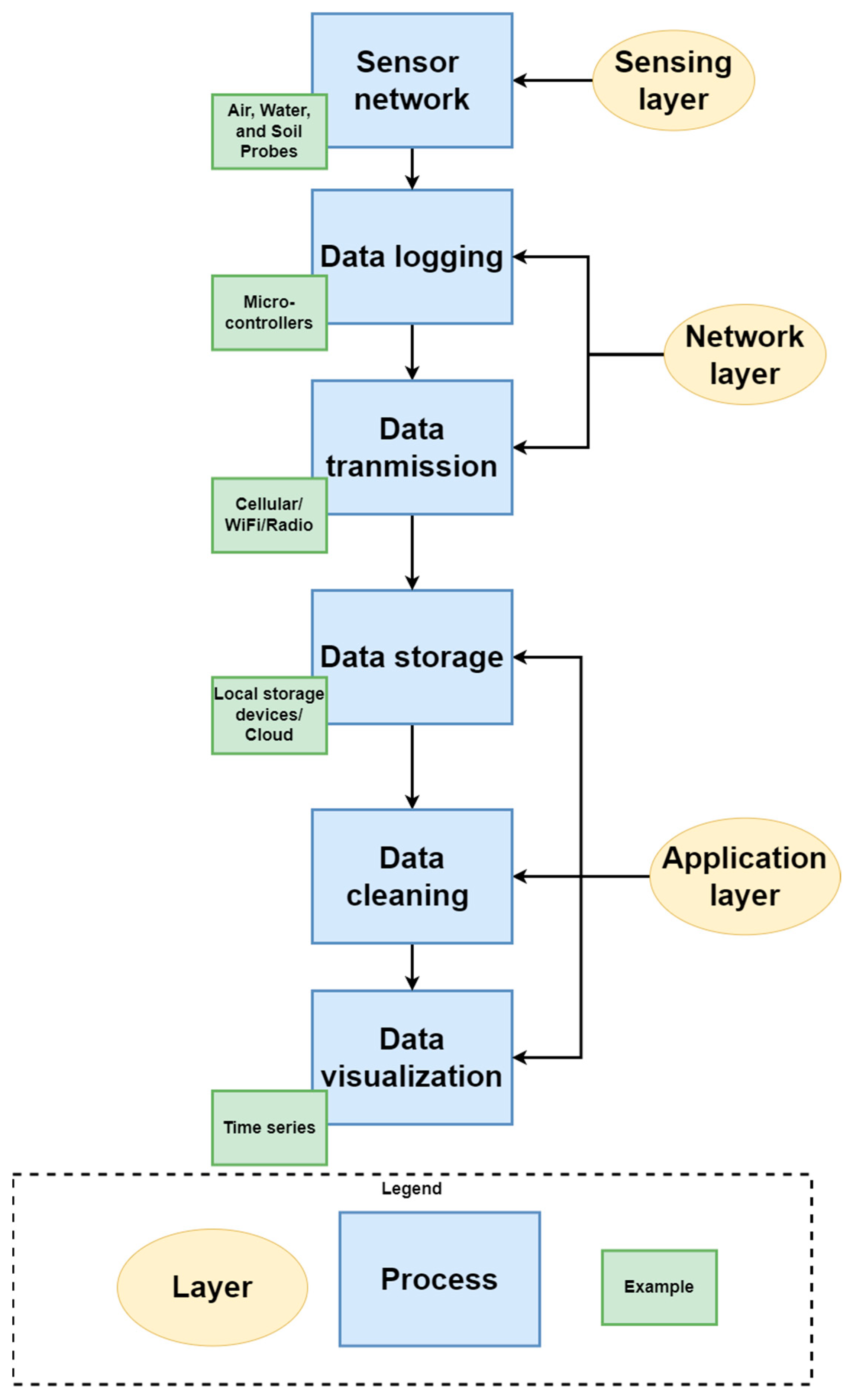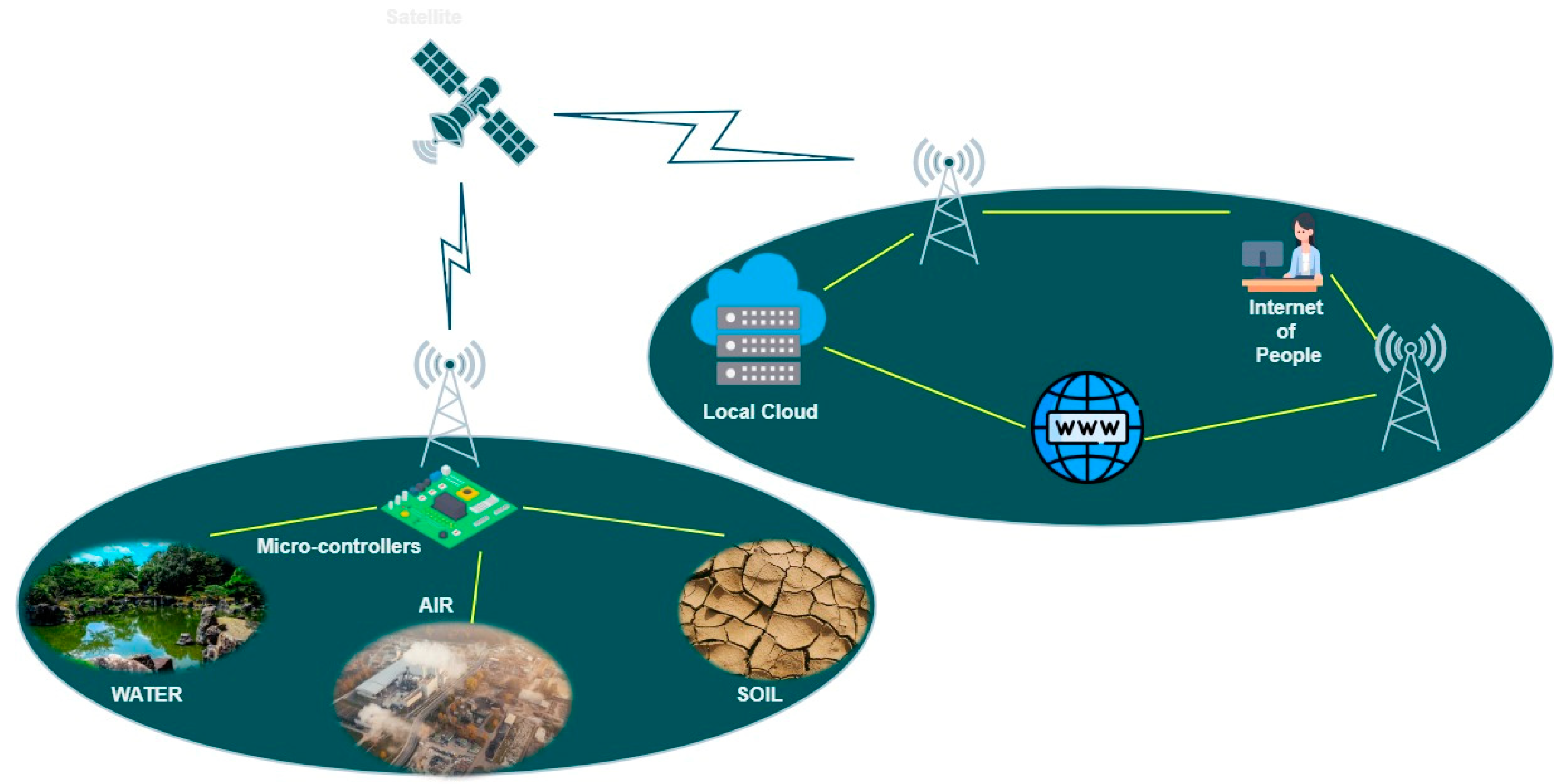Applications of the Internet of Things (IoT) in Real-Time Monitoring of Contaminants in the Air, Water, and Soil †
Abstract
:1. Introduction
2. System Design and Implementation
2.1. Framework
2.2. Smart Monitoring Systems Using IoTs
2.2.1. Air Quality
- = the rounded concentration of the pollutant;
- = the breakpoint that is greater than or equal to ;
- = the breakpoint that is less than or equal to ;
- = the AQI value corresponding to ;
- = the AQI value corresponding to .
2.2.2. Freshwater Quality
2.2.3. Soil Quality
3. Challenges to Applying IoT Architecture for Environmental Monitoring
3.1. Identification and Scalability
3.2. Data Management
3.3. Security and Privacy of Sensitive Data
3.4. Energy Efficiency
3.5. Adaptive Sensing
3.6. Discussion
4. Test Case of IoT Monitoring Network for Water Quality
4.1. Geo-Spatial Watershed Monitoring
4.2. Water Quality Time Series
5. Conclusions
- Data-driven deep learning for adaptive sensing applications and improving the functional capability of IoT systems with minimum human interference;
- Big data cleaning is necessary due to a large sensor network collecting diverse information such that cloud computing can play a vital role in providing processing power for data cleaning and visualization;
- Data denoising is necessary while dealing with big data of IoT networks especially while collecting dynamic environmental systems which are affected by external climatic and weather events.
Author Contributions
Funding
Institutional Review Board Statement
Informed Consent Statement
Data Availability Statement
Acknowledgments
Conflicts of Interest
References
- Kirkhorn, S.R.; Schenker, M.B. Current Health Effects of Agricultural Work: Respiratory Disease, Cancer, Reproductive Effects, Musculoskeletal Injuries, and Pesticide–Related Illnesses. J. Agric. Saf. Health 2002, 8, 16. [Google Scholar] [CrossRef]
- Nordberg, G.F. Human Health Effects of Metals in Drinking Water: Relationship to Cultural Acidification. Environ. Toxicol. Chem. 1990, 9, 887–894. [Google Scholar] [CrossRef]
- Calderon, R.L.; Johnson, C.C.; Craun, G.F.; Dufour, A.P.; Karlin, R.J.; Sinks, T.; Valentine, J.L. Health Risks from Contaminated Water: Do Class and Race Matter? Toxicol. Ind. Health 1993, 9, 879–900. [Google Scholar] [CrossRef]
- Fulekar, M.; Pathak, B.; Kale, R.K. Environment and Sustainable Development; Springer: Berlin/Heidelberg, Germany, 2014; ISBN 81-322-1166-9. [Google Scholar]
- Carley, M.; Christie, I. Managing Sustainable Development; Routledge: London, UK, 2017; ISBN 1-315-09152-6. [Google Scholar]
- Lovett, G.M.; Burns, D.A.; Driscoll, C.T.; Jenkins, J.C.; Mitchell, M.J.; Rustad, L.; Shanley, J.B.; Likens, G.E.; Haeuber, R. Who Needs Environmental Monitoring? Front. Ecol. Environ. 2007, 5, 253–260. [Google Scholar] [CrossRef]
- Behera, T.M.; Mohapatra, S.K.; Samal, U.C.; Khan, M.S.; Daneshmand, M.; Gandomi, A.H. I-SEP: An Improved Routing Protocol for Heterogeneous WSN for IoT-Based Environmental Monitoring. IEEE Internet Things J. 2019, 7, 710–717. [Google Scholar] [CrossRef]
- Rajalakshmi, P.; Mahalakshmi, S.D. IOT Based Crop-Field Monitoring and Irrigation Automation. In Proceedings of the 10th International Conference on Intelligent Systems and Control (ISCO), Coimbatore, India, 7–8 January 2016; pp. 1–6. [Google Scholar]
- Parra, L.; Sendra, S.; García, L.; Lloret, J. Design and Deployment of Low-Cost Sensors for Monitoring the Water Quality and Fish Behavior in Aquaculture Tanks during the Feeding Process. Sensors 2018, 18, 750. [Google Scholar] [CrossRef] [Green Version]
- Karagulian, F.; Barbiere, M.; Kotsev, A.; Spinelle, L.; Gerboles, M.; Lagler, F.; Redon, N.; Crunaire, S.; Borowiak, A. Review of the Performance of Low-Cost Sensors for Air Quality Monitoring. Atmosphere 2019, 10, 506. [Google Scholar] [CrossRef] [Green Version]
- Liu, X.; Jayaratne, R.; Thai, P.; Kuhn, T.; Zing, I.; Christensen, B.; Lamont, R.; Dunbabin, M.; Zhu, S.; Gao, J.; et al. Low-Cost Sensors as an Alternative for Long-Term Air Quality Monitoring. Environ. Res. 2020, 185, 109438. [Google Scholar] [CrossRef]
- Marios, S.; Georgiou, J. Precision Agriculture: Challenges in Sensors and Electronics for Real-Time Soil and Plant Monitoring. In Proceedings of the 2017 IEEE Biomedical Circuits and Systems Conference (BioCAS), Turin, Italy, 19–21 October 2017; pp. 1–4. [Google Scholar]
- Schubert, T.W.; D’Ausilio, A.; Canto, R. Using Arduino Microcontroller Boards to Measure Response Latencies. Behav. Res. 2013, 45, 1332–1346. [Google Scholar] [CrossRef] [Green Version]
- Yang, Z.; Yue, Y.; Yang, Y.; Peng, Y.; Wang, X.; Liu, W. Study and Application on the Architecture and Key Technologies for IOT. In Proceedings of the 2011 International Conference on Multimedia Technology, Hangzhou, China, 26–28 July 2011; pp. 747–751. [Google Scholar]
- Pi, R. Raspberry Pi 3 Model. Available online: https://www.raspberrypi.com/products/raspberry-pi-3-model-b/ (accessed on 2 October 2022).
- Hyun Park, S.; Seon Shin, W.; Hyun Park, Y.; Lee, Y. Building a New Culture for Quality Management in the Era of the Fourth Industrial Revolution. Total Qual. Manag. Bus. Excell. 2017, 28, 934–945. [Google Scholar] [CrossRef]
- Nie, X.; Fan, T.; Wang, B.; Li, Z.; Shankar, A.; Manickam, A. Big Data Analytics and IoT in Operation Safety Management in Under Water Management. Comput. Commun. 2020, 154, 188–196. [Google Scholar] [CrossRef]
- Materne, N.; Inoue, M. IoT Monitoring System for Early Detection of Agricultural Pests and Diseases. In Proceedings of the 2018 12th South East Asian Technical University Consortium (SEATUC), Yogyakarta, Indonesia, 12–13 March 2018; pp. 1–5. [Google Scholar]
- Taştan, M. An IoT Based Air Quality Measurement and Warning System for Ambient Assisted Living. Avrupa Bilim Ve Teknol. Derg. 2019, 960–968. [Google Scholar] [CrossRef]
- Zhang, H.; Srinivasan, R. A Systematic Review of Air Quality Sensors, Guidelines, and Measurement Studies for Indoor Air Quality Management. Sustainability 2020, 12, 9045. [Google Scholar] [CrossRef]
- US EPA, O. Air Data Basic Information. Available online: https://www.epa.gov/outdoor-air-quality-data/air-data-basic-information (accessed on 13 September 2022).
- US EPA. Technical Assistance Document for the Reporting of Daily Air Quality | AirNow.Gov. Available online: https://www.airnow.gov/sites/default/files/2020-05/aqi-technical-assistance-document-sept2018.pdf (accessed on 2 September 2022).
- US EPA. R. 10 Freshwater Quality. Available online: https://www.epa.gov/salish-sea/freshwater-quality (accessed on 13 September 2022).
- Soil Health | NRCS Arkansas. Available online: https://www.nrcs.usda.gov/wps/portal/nrcs/ar/soils/health/ (accessed on 13 September 2022).
- Amacher, M.C.; O’Neil, K.P.; Perry, C.H. Soil Vital Signs: A New Soil Quality Index (SQI) for Assessing Forest Soil Health; U.S. Department of Agriculture, Forest Service: Fort Collins, CO, USA, 2007; 12p.
- Chellappa, J.; Sagar, K.L.; Sekaran, U.; Kumar, S.; Sharma, P. Soil Organic Carbon, Aggregate Stability and Biochemical Activity under Tilled and No-Tilled Agroecosystems. J. Agric. Food Res. 2021, 4, 100139. [Google Scholar] [CrossRef]
- de Melo, G.C.G.; Torres, I.C.; de Araújo, Í.B.Q.; Brito, D.B.; Barboza, E.d.A. A Low-Cost IoT System for Real-Time Monitoring of Climatic Variables and Photovoltaic Generation for Smart Grid Application. Sensors 2021, 21, 3293. [Google Scholar] [CrossRef]
- Mulyono, A.; Suriadikusumah, A.; Harriyanto, R.; Djuwansah, M.R. Soil Quality under Agroforestry Trees Pattern in Upper Citarum Watershed, Indonesia. J. Ecol. Eng. 2019, 20, 203–213. [Google Scholar] [CrossRef]
- Nandgaonkar, S.V.; Raut, A. A Comprehensive Study on Cloud Computing. Int. J. Comput. Sci. Mob. Comput. 2014, 3, 733–738. [Google Scholar]
- DeSimone, J.A.; Harms, P. Dirty Data: The Effects of Screening Respondents Who Provide Low-Quality Data in Survey Research. J. Bus. Psychol. 2018, 33, 559–577. [Google Scholar] [CrossRef]
- Jain, P.; Gyanchandani, M.; Khare, N. Big Data Privacy: A Technological Perspective and Review. J. Big Data 2016, 3, 1–25. [Google Scholar] [CrossRef] [Green Version]
- Kindervag, J. No More Chewy Centers: The Zero Trust Model of Information Security. Available online: https://www.forrester.com/report/No-More-Chewy-Centers-The-Zero-Trust-Model-Of-Information-Security/RES56682 (accessed on 24 March 2016).
- Safara, F.; Souri, A.; Baker, T.; Al Ridhawi, I.; Aloqaily, M. PriNergy: A Priority-Based Energy-Efficient Routing Method for IoT Systems. J. Supercomput. 2020, 76, 8609–8626. [Google Scholar] [CrossRef]
- Hossein Motlagh, N.; Mohammadrezaei, M.; Hunt, J.; Zakeri, B. Internet of Things (IoT) and the Energy Sector. Energies 2020, 13, 494. [Google Scholar] [CrossRef]
- Chittoor, P.K.; Chokkalingam, B.; Mihet-Popa, L. A Review on UAV Wireless Charging: Fundamentals, Applications, Charging Techniques and Standards. IEEE Access 2021, 9, 69235–69266. [Google Scholar] [CrossRef]
- Kobeissi, A.H.; Bellotti, F.; Berta, R.; De Gloria, A. IoT Grid Alignment Assistant System for Dynamic Wireless Charging of Electric Vehicles. In Proceedings of the 2018 Fifth International Conference on Internet of Things: Systems, Management and Security, Valencia, Spain, 15–18 October 2018; pp. 274–279. [Google Scholar]
- Chandre, P.R.; Mahalle, P.N.; Shinde, G.R. Deep Learning and Machine Learning Techniques for Intrusion Detection and Prevention in Wireless Sensor Networks: Comparative Study and Performance Analysis. In Design Frameworks for Wireless Networks; Das, S.K., Samanta, S., Dey, N., Kumar, R., Eds.; Lecture Notes in Networks and Systems; Springer: Singapore, 2020; pp. 95–120. ISBN 9789811395741. [Google Scholar]
- Dhingra, S.; Madda, R.B.; Gandomi, A.H.; Patan, R.; Daneshmand, M. Internet of Things Mobile–Air Pollution Monitoring System (IoT-Mobair). IEEE Internet Things J. 2019, 6, 5577–5584. [Google Scholar] [CrossRef]
- Kamaludin, K.H.; Ismail, W. Water Quality Monitoring with Internet of Things (IoT). In Proceedings of the 2017 IEEE Conference on Systems, Process and Control (ICSPC), Meleka, Malaysia, 15–17 December 2017; pp. 18–23. [Google Scholar]






| Ambient Air Quality | AQI |
|---|---|
| Good | 0–50 |
| Moderate | 51–100 |
| Unhealthy for sensitive groups | 101–150 |
| Unhealthy | 151–200 |
| Very Unhealthy | 201–300 |
| Hazardous | 301–500 |
| Water Quality | WQI |
|---|---|
| Excellent | 95–100 |
| Good | 80–94 |
| Fair | 60–79 |
| Marginal | 45–59 |
| Poor | 0–44 |
| Soil Quality | SQI |
|---|---|
| Very Good | 0.80–1.00 |
| Good | 0.60–0.79 |
| Moderate | 0.40–0.59 |
| Low | 0.20–0.39 |
| Very Low | 0.00–0.19 |
| Soil Quality | SQI | Methods Used | Reference |
|---|---|---|---|
| Soil monitoring for farming | 0.80–1.00 | Wireless sensor network with IoT | [37] |
| Air pollution monitoring | 0.60–0.79 | Air pollution sensors integrated with IoT | [38] |
| Water pollution monitoring | 0.40–0.59 | Stream monitoring sensors integrated with IoT | [39] |
Publisher’s Note: MDPI stays neutral with regard to jurisdictional claims in published maps and institutional affiliations. |
© 2022 by the authors. Licensee MDPI, Basel, Switzerland. This article is an open access article distributed under the terms and conditions of the Creative Commons Attribution (CC BY) license (https://creativecommons.org/licenses/by/4.0/).
Share and Cite
Pamula, A.S.P.; Ravilla, A.; Madiraju, S.V.H. Applications of the Internet of Things (IoT) in Real-Time Monitoring of Contaminants in the Air, Water, and Soil. Eng. Proc. 2022, 27, 26. https://doi.org/10.3390/ecsa-9-13335
Pamula ASP, Ravilla A, Madiraju SVH. Applications of the Internet of Things (IoT) in Real-Time Monitoring of Contaminants in the Air, Water, and Soil. Engineering Proceedings. 2022; 27(1):26. https://doi.org/10.3390/ecsa-9-13335
Chicago/Turabian StylePamula, Abhiram S. P., Achyuth Ravilla, and Saisantosh Vamshi Harsha Madiraju. 2022. "Applications of the Internet of Things (IoT) in Real-Time Monitoring of Contaminants in the Air, Water, and Soil" Engineering Proceedings 27, no. 1: 26. https://doi.org/10.3390/ecsa-9-13335








